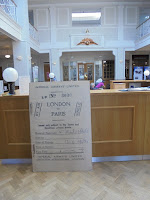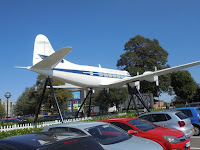West Norwood Bus Garage to Marylebone Station
Thursday September 27
2018
Jo was a little anxious that as I was blogging three routes
on the trot people (our followers) might think she was dead. Far from it – she
may shortly be due an upgraded eye but it just so happens that I had not ridden
the original 2009 numbers 1-4 and was keen to rectify this, but she is raring
to go.
As was the Number 2 – we barely had time to swop cameras for
pens and board the frequent service that starts just outside the bus garage. Jo
remembers being quite worried about where she might land up when she first rode
this route alone as for North Londoners it does seem quite remote. It starts
uphill and from the top deck there is a good view of the various taller London
buildings we have acquired over the last years. It also passes close to St
Luke’s church, the first of the Evangelists (2/4 today) which now forms
something of a traffic island just opposite West Norwood cemetery. Counting as
one of the Big Seven the latter is well worth a visit. I see the tour includes some catacombs – the ultimate in spooky experiences.
The inward bound route was much busier than our earlier 68
including a mother and daughter going quite a long way. This southern approach
to Brixton has smartened up somewhat since we were last round this way –
evidence of gentrification included Brockwell Blend.
From this route, as opposed to routes 3
and 68, it is not obvious that Brockwell Park is nearby as both sides of the
road are well built up – the extensive Tulse Hill Estate
and its opposite numbers masking the access to the park. Considering they date from 1939 in the
sunshine the flats were looking quite sprightly and quiet. The run in to
Brixton itself passes the second Evangelist (or the first if you are blessing
the bed you lie on) Church, whose clock we found less legible. Developers were
taking advantage of the venue Brixton Electric to build some flats called
Eclectic Electric. Considering the large
numbers of routes that come through Brixton we transited fairly fast – Jo spotted some graffiti (sadly
itself graffittied) on the railway
bridge which told us: Clapham that way< you 2D Flat White Tepid Colonialist Yuppy, which tells you how the area continues to
change.. .
We headed left towards Stockwell and again much had changed
– previously the Portuguese pastry shops had taken over from the old second
hand car dealerships, now many of these had in turn been displaced , even
demolished, in favour of new blocks as can be seen adjacent to the skateboard park which won a reprieve, and is
promised a repair courtesy of the developer building the overlooking ‘luxury’
flats.
We made good progress to Stockwell and its war memorial
roundabout – looking distinctly shabby was the memorial to Violette Szabo with
the colourful murals peeling somewhat.
We enjoyed the stretch to Vauxhall – many of the older
houses are still intact and well maintained and it is easy to see why parts of
it are in a conservation area.
We were a bit puzzled by the bus stop named Tate Library
(does the Museum keep its books separate from its artworks?) but this in fact
refers to a small Victorian local
library named for the man who made his
money from sugar courtesy of his slaves..
As we approached Vauxhall
the buildings get taller and more modern, including some that look as
though they are clad with random Lego bricks – nasty we agreed – not that we
dislike Lego but we’d rather not have
something similar on a building. Still we were cheered by the site of Vauxhall
Bus Station where pedestrians and buses
are kept well in order under a wavy canopy – this building in turn is mocked by
many but at least it is more cheerful than the gloom that is Vauxhall railway
station which is dark and muddling
without the cheerful bustle of Clapham Junction.
We crossed the river with the tide so far out the mud flats looked
like a beach. The little girl passenger got quite excited
and said ‘Mummy, there’s a big river.’ Indeed. Once over I always feel Pimlico
lacks personality , at least the bit you
cover between the bridge and Victoria Station , perhaps because the buildings
date from so many eras, though of course that is usual in London. The once
black-only London cabs were lined up thus exemplifying ‘cab ranking’ in its
truest form.
Talking of lack of cohesion, approaching Victoria from this
way you are faced with a perplexing jumble of new builds where clearly no one
took an overview: there is a red wedge-shaped thing alongside a greeny
glasshouse , and they both tower over
some small Edwardian era red bricks
just across the road from the theatre where ‘Wicked’ is still running. In
contrast to this the exterior of Victoria station appears self-contained.
Passing Grosvenor Place and the small gardens we could see
it was nearly lunchtime by the number of people enjoying the sun ... and their
lunches. Lunch al fresco in a London green space always strikes me as truly
democratic as your hard-hatted builders
are just as likely to be relaxing as
the junior bankers. Jo couldn’t resist
pointing out the Queen’s trees to our other passengers, which is just about all
you can see of Buckingham Palace gardens even from the top deck.
There is building too at Hyde Park Corner - another Grand Hotel . We did not remember our visit to No 1 London (the Dukes of Wellington residence) with
great fondness as we found it a dark and rather fossilised
Park Lane, in spite of its bucolic name, is really rather a
heavy duty road, so we only just glimpsed the several memorials along here –
the rather over ornate Queen Mother gates, the by contrast nicely simple 7/7
posts, and then the Animals at war. More building at Marble Arch – a whole
corner is under construction.
This route barely trifles with Oxford Street before heading
down Gloucester Place – the houses round here are most attractive so it is not
surprising that there was at least one blue plaque to be spotted. More
arresting was a yellow diversion sign but the Number 2 kept to its course and
turned left to leave us by Marylebone Station. Such faded grandeur I always
think: dignified, still functioning, quietly getting on with being a station
and not shouting about it like King’s Cross.
Our trip from modest outer SE London to costly Marylebone
had taken 75 minutes.
PS This is a far cry from my ‘school bus’ 2A which did the
Marylebone to Finchley bit….












































